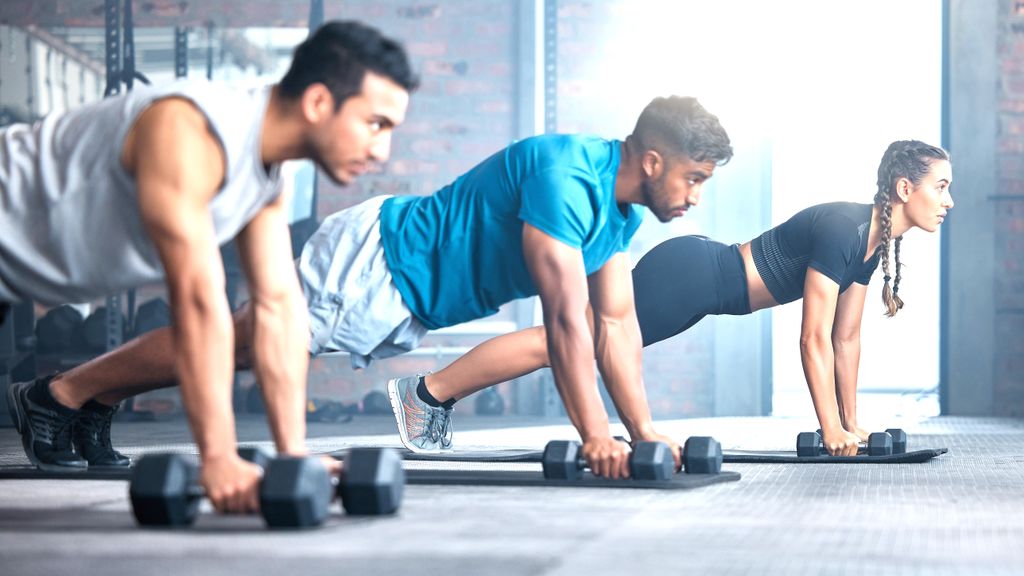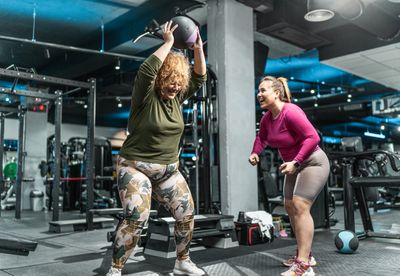
If you want a fun full-body workout that builds strength and cardio, consider trying circuit training with weights. Many individuals enjoy circuit training with weights because it’s a quick session you can complete at home or the gym with minimal equipment. Plus, it’s customizable and perfect for any fitness level.
An Introduction to Circuit Training
Circuit training is when you complete a series of exercises with little to no rest between movements. Once you finish the exercise series, you take a longer break before continuing with another set.
Most circuit training workouts have six to ten exercises per set, and you’ll complete the set two or three times. However, people enjoy circuit training because you can customize the workout to meet your fitness goals. Therefore, you can choose the number of exercises and sets that feel best for you.
Exercises within a circuit training workout can vary depending on fitness goals. Many circuit training workouts will encompass the entire body, but some may focus on specific muscle groups such as legs or core. You can also have a cool-down circuit that focuses on stretching and slowing the heart rate or a warmup circuit to prepare the body for a high-intensity workout.
Where To Do Circuit Workout with Weights
One of the best things about circuit training is that you can do it anywhere. Plenty of circuit training workouts use your body weight, making them ideal at home. If you have access to weights at home, such as dumbbells, kettlebells, or medicine balls, you can incorporate them to build muscle and strength. At a gym, you can also do a circuit training workout with weight machines.
A circuit training class is an excellent way to introduce yourself to circuit training. Many group fitness gyms have circuit training sessions where an instructor guides you through the exercises and ensures you have the proper technique. You can also work one-on-one with a certified fitness instructor who can teach you how to safely execute various movements and show you have to put together a circuit training workout that fits your fitness needs.
Safety Precautions for Circuit Training with Weights
When working out with weights, you should take a few safety precautions to reduce the risk of injury.
Ensure you know how to execute exercises correctly. If you don’t know how to do something safely, talk to a fitness instructor or personal trainer who can show you the proper form and technique.
Work out with a partner when you’re using heavy weights. It’s always best to have a partner to spot you whenever you’re using heavy weights in a workout.
Use light weights if you’re alone. When you’re at home or don’t have someone to join you for a workout, stay safe by using light hand weights, no more than 15 lbs.
Understand the difference between discomfort and pain. It’s natural to feel discomfort when pushing yourself through a strenuous workout. However, there is a difference between discomfort and pain. If you’re feeling pain while lifting, stop working out, let your body rest, and talk with your doctor before proceeding to ensure you haven’t endured an injury.
Types of Circuit Training
There are various ways to categorize circuit training workouts, but three common types include repetition, timed, and sports-specific.
Repetition
A repetition circuit is when you perform each exercise for a certain number of reps. After you complete the reps, you take a short break before moving on to the next exercise.
Timed
A timed circuit is when you perform each exercise for a set time, usually around 45 secs to one minute. Your goal is to complete as many reps as possible.
Sports-specific
Athletes often work on sports-specific circuits to build skills needed for their sports. A boxer may work a circuit that involves punching a heavy bag, working a speed ladder, and hitting pads. Or a basketball play may do a circuit trying to shoot from different spots on the court.
Get our fitness newsletter
Stay on track with your fitness goals and get inspired! Sign up for the GymBird newsletter for twice-monthly expert fitness and nutrition tips.
If you’re new to incorporating weights into a circuit training routine, Jonathan Tylicki, NASM-CPT, CES, PES, Master Trainer and Director of Education at AKT, says just know that not every exercise needs to utilize weights – it doesn’t have to be all or nothing! “Since circuit training involves doing a series of exercises, typically in rounds, two of the best ways to incorporate weights are either by alternating or progression,” he says.
Alternating involves alternating the exercises in a circuit between utilizing weights or resistance and bodyweight. For example, Jonathan Tylicki says you could perform a dumbbell shoulder press with weight, then a set of jumping jacks, followed by bent over rows with resistance, and finish with high knees.
Progression, he says, involves adding more weight each time you repeat a circuit. For example, a three-round circuit might look like this: Round one with no weight, round two with light weight, and round three with medium weight.
Benefits of Circuit Training with Weights
People love circuit training because it’s a great workout that builds strength and cardio. But it’s also customizable, easy to schedule, and perfect for people of all fitness levels.
Fits busy schedules
The time a circuit training workout takes depends on the number of exercises, reps, and sets. You can do a 45-minute or hour-long circuit, but many enjoy circuit training because you can get a sufficient workout in 20 to 30 minutes.
Customizable
You can customize your circuit training workout to fit your fitness goals or experience level. You can incorporate arm and core exercises with varying weights to focus on building upper body or core strength. If you enjoy lifting but also want to improve your cardio, you can alternate heavy-weighted movements with cardio bursts.
Besides choosing the exercises within the circuit, you can customize circuit training workouts by adding weights, only using body weight, increasing or decreasing the number of reps, and adding or taking away exercises for a longer or shorter workout. And circuits aren’t just for strength and cardio. You can do a yoga circuit to improve mobility or a stretching circuit for better flexibility.
Accommodates All Skill Levels
Since circuit training with weights is customizable, it is an excellent workout for people of all fitness levels. If you’re new to working out and trying a repetition circuit, start with the minimum recommended reps and complete one set. Once you feel more comfortable with the workout, try increasing the reps or adding additional sets. If you’re using weights, always start with a light weight, and work your way up to something heavier as you build strength.
If you’re a circuit training veteran, you can increase the intensity by using heavier weights, adding more reps, or adding additional sets. You can also include more exercises per set or decrease the recovery time between exercises.
Improves Muscular Endurance
You can increase muscle growth and improve muscular endurance with weight-lifting circuits
Muscle endurance is how long your body can sustain an exercise. Muscle growth occurs when you lift moderate to heavy weights for many reps. If you’re consistently circuit training with weights and pushing yourself to hit high reps, you’ll find you can perform exercises for longer without fatigue and lift heavier weights for more reps.
Best Gyms for a Circuit Workout with Weights
You can do circuit training with weights at home, at the gym, or a combination of both. One thing that makes this workout style so flexible is that most fitness facilities are designed for circuit training, with some even having designated circuit training spaces for individual or group workouts.
Because circuit training with weights is something you can do at any gym, finding the best one to suit your needs is easy. In fact, many national gym chains like Crunch Fitness, Planet Fitness, YMCA, Gold’s Gym, Life Time Fitness, Anytime Fitness, 24-Hour Fitness, LA Fitness, and Equinox offer circuit training group classes or have designated circuit training areas in the facility.
But if you want a more structured, instructor-led experience, check out Orangetheory (see our Orangetheory review) and F45. These speciality studios are similar to a circuit training routine, allowing you to move between cardio and resistance-based exercises.
Orangetheory
Best for Circuit Training
A modified high-intensity interval training (HIIT) gym that uses heart rate monitoring technology to help members maximize their workout and burn calories both during and after their session.
Group classes
Community-focused
Tracked workouts & stats
Best Equipment for a Circuit Workout with Weights
Circuit training with weights allows you to challenge upper and lower body muscles in one time-efficient workout. Because you’re targeting full-body exercises, you'll want equipment that's versatile and easy to use.
If you do most of your training at the gym, there’s a good chance you’ll have access to a variety of gear and in various resistance levels.
But if you’re looking to build a home gym, you may want to start with a few staples like kettlebells and dumbbells and then add items as you become more experienced.
With that in mind, here are some top picks for resistance-based circuit training equipment.
Dumbbells
Dumbbells are an easy way to incorporate weight into your circuit routine for exercises like lunges, rows, shoulder press, biceps curl, and chest press.
Kettlebells
Kettlebells are great for exercises like kettlebell swings, goblet squats, and shoulder press. .
Resistance Bands
Exercise bands allow you to add resistance to moves like biceps curls, shoulder presses, squats, lateral raises, triceps extension, and rows. Resistance bands are color-coded based on resistance.
Strength Training Equipment
Most gms and fitness facilities have a free weight area with dumbbells, racks, benches, and barbells. Many also have a circuit-style area with resistance machines such as the leg press, hamstring curl, shoulder press, lat pulldown, row, and chest press. You can also use a TRX suspension trainer to do a wide range of bodyweight exercises like pull-ups, squats, chest press, rows, and planks.
Best Apps for Circuit Workouts with Weights
Circuit training with weights is a great way to build strength, endurance, and burn calories. And getting started is even easier with the help of a fitness app.
Fitness apps offer a variety of workouts, exercises, and training programs, including live and on-demand classes geared towards circuit training with weights.
Many platforms also have robust exercise databases with how-to videos and instructions, so you can build your own routine. Here are some of our favorite apps for circuit training with weights.
Best for Personal Training: Future
Best for Serious Strength Training: Centr (7 day free trial here)
Best for Live and On-Demand Classes: Peloton
Best for Building a Routine: JEFit
Future
Best for Virtual Personal Training
This interactive fitness training platform offers flexibility, variety, daily motivation, and access to hundreds of expert trainers and coaches ready to design a program tailored to your fitness level, goals, equipment availability, schedule, and personal preferences.
Apple Watch Rental Program
Record Mode for better coaching & feedback
Select Your Coach
Circuit Training with Weights Sample Workouts
Use the sample workouts below if you feel confident to try a circuit training workout with weights. Each workout will say whether you need a pair of dumbells or a pair of kettlebells.
A couple of 10lb, 12lb, or 15lb weights may work best, but you can always use heavier or lighter depending on your body. Also, feel free to exchange weights during the workout or use different weights for each exercise.
When it comes to the number of circuit training sessions, Landon Uetz, PT, DPT, virtual physical therapist and expert instructor on TeachMe, says to aim for two to three days per week, working all muscle groups. “The goal should be by the end of each set, an exercise should be challenging, and over time you will want to slowly increase the difficulty of a movement or exercise as you get stronger,” he adds.
Repetition Strength Circuit with Weights
Weights: For this strength circuit, you’ll need either a pair of dumbells or a pair of kettlebells.
| Exercise | Reps | Sets | Reset |
|---|---|---|---|
| Squats | 12-15 | 2-3 | >15 sec |
| Bent over rows | 10-12 | 2-3 | >15 sec |
| Bicep curls | 10-12 | 2-3 | >15 sec |
| Alternating forward lunges with a core rotation | 6-8 each leg | 2-3 | >15 sec |
| Shoulder press | 10-12 | 2-3 | >15 sec |
| Alternating backward lunges with a core rotation | 6-8 each leg | 2-3 | >15 sec |
| Deadlifts | 12-15 | 2-3 | 1 min |
Repetition Strength-Cardio Circuit with Weights
Weights: For this strength-cardio circuit, you’ll need a pair of 10lb, 12lb, or 15lb dumbells.
| Exercise | Reps | Sets | Reset |
|---|---|---|---|
| Squat with a chest press | 10-12 | 2-3 | >15 sec |
| Bicep curls | 10-12 | 2-3 | >15 sec |
| Dumbell punch jacks | 12-15 | 2-3 | >15 sec |
| Alternating curtsy squats | 6-8 each leg | 2-3 | >15 sec |
| Hammer curls | 10-12 | 2-3 | >15 sec |
| High knees with a dumbbell at the chest | 8-10 each leg | 2-3 | >15 sec |
| Alternating reverse lunges with core rotation | 6-8 each leg | 2-3 | 1 min |
Timed Strength-Cardio Circuit
Weights: For this strength-cardio circuit, you’ll need a pair of 10lb, 12lb, or 15lb dumbells.
| Exercise | Rep Time | Sets | Reset |
|---|---|---|---|
| Dumbell pushups with alternating rows | 45 sec | 2-3 | 15 sec |
| Squats with a shoulder press | 45 sec | 2-3 | 15 sec |
| High knees with a dumbbell at the chest | 45 sec | 2-3 | 15 sec |
| Dumbell situps with an overhead reach | 45 sec | 2-3 | 15 sec |
| Alternating forward lunges with a bicep curl | 45 sec | 2-3 | 15 sec |
| Dumbell punch jacks | 45 sec | 2-3 | 1 min |
Circuit Training with Weights Workout Videos
20 Minute Full Body Dumbbell Workout – Circuit Training: Strength, Conditioning & Core
30 Minute Circuit Training with Weights
More Circuit Training Advice from GymBird Experts
- What is Circuit Training?
- Circuit Training for Beginners
- Circuit Training Workouts
- Best Circuit Training Workouts for Athletes
- Best Circuit Training for Runners
- Circuit Training Benefits
- Circuit Training vs. Cross Training
- Circuit Training vs. CrossFit
- Circuit Training vs. HIIT
- Is Circuit Training Aerobic or Anaerobic?





